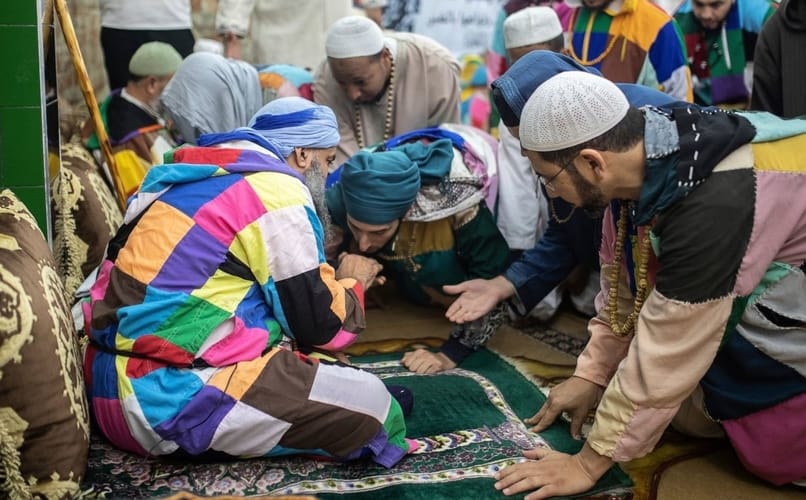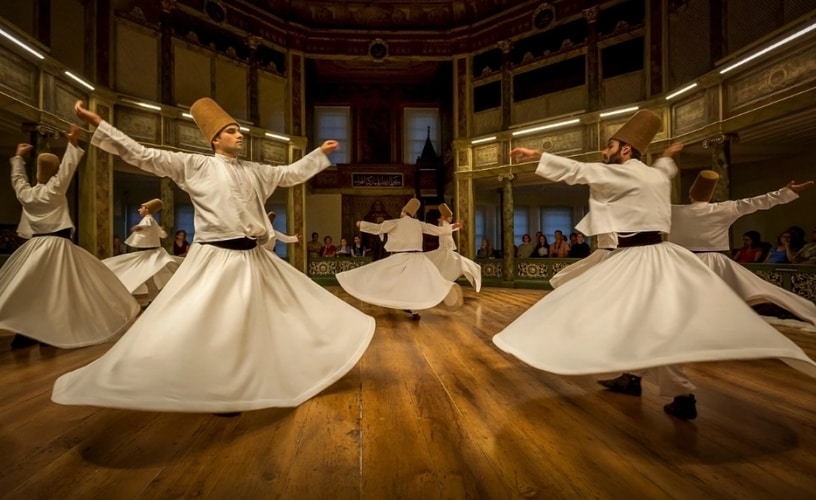All About Sufi Orders
Sufism emerged early on in Islamic history, partly as a reaction against the worldliness of the early Umayyad Caliphate (661–750). Although Sufis were opposed to dry legalism, they strictly observed Islamic law and belonged to various schools of Islamic jurisprudence and theology. Although the overwhelming majority of Sufis, both pre-modern and modern, remain adherents of Sunni Islam, certain strands of Sufi practice developed within the ambit of Shia Islam during the late medieval period, particularly after the Safavid conversion of Iran.
Sufism is often erroneously referred to as a sect or as a fringe minority, however, Sufi thought and practice extends beyond the Sunni-Shia sectarian divide, across socio-economic boundaries, geographies, and languages. Sufi orders, known as Tariqas, are found throughout the Muslim world, with each order taking on its own distinct identity based on its practices and structure, and often reflecting the cultural and linguistic context in which it is set.
While structures vary greatly between different Sufi orders, the basic components are that of the murshid, the spiritual guide, and the murid, a follower who pledges allegiance, bayah, to the murshid. These spiritual guides derive their authority and legitimacy from a chain of successive tutelage and instruction, silsilah, which through continuous generations may reach back to a prominent saint or mystic and eventually to the Prophet Muhammad himself. The role of the murshid is to act as a facilitator to the murid, instructing them on how to experience the divine.
Despite a relative decline of Sufi orders in the modern era, Sufism has continued to play an important role in the Islamic world and has also influenced various forms of spirituality in the West.
Sufi orders:
Historically, Sufis have often belonged to “orders” known as tariqa (pl. ṭuruq) – congregations formed around a grandmaster wali who will trace their teaching through a chain of successive teachers back to the Islamic prophet Muhammad. These orders meet for spiritual sessions (majalis) in meeting places known as zawiyas, khanqahs, or tekke.
They strive for Ihsan (perfection of worship), as detailed in a hadith: “Ihsan is to worship Allah as if you see Him; if you can’t see Him, surely He sees you.” Sufis regard Muhammad as al-Insān al-Kāmil, the complete human who personifies the attributes of Absolute Reality and view him as their ultimate spiritual guide.
Sufi orders trace most of their original precepts from Muhammad through Ali ibn Abi Talib, with the notable exception of the Naqshbandi Order, which traces their original precepts to Muhammad through Abu Bakr. However, it was not necessary to formally belong to a tariqa. In the Medieval period, Sufism was almost equal to Islam in general and not limited to specific orders.
Sufism had a long history already before the subsequent institutionalization of Sufi teachings into devotional orders (tariqa, pl. tarîqât) in the early Middle Ages. The term tariqa is used for a school or order of Sufism, or especially for the mystical teaching and spiritual practices of such an order to seek ḥaqīqah (ultimate truth). A tariqa has a murshid (guide) who plays the role of leader or spiritual director. The members or followers of a tariqa are known as murīdīn (singular murīd), meaning “desirous”, viz. “desiring the knowledge of knowing God and loving God”.
Over the years, Sufi orders have influenced and been adopted by various Shi’i movements, especially Isma’ilism, which led to the Safaviyya order’s conversion to Shia Islam from Sunni Islam and the spread of Twelverism throughout Iran.
Prominent tariqa include the Ba ‘Alawiyya, Badawiyya, Bektashi, Burhaniyya, Chishti, Khalwati, Kubrawiya, Madariyya, Mevlevi, Muridiyya, Naqshbandi, Nimatullahi, Qadiriyya, Qalandariyya, Rahmaniyya, Rifa’i, Safavid, Senussi, Shadhili, Suhrawardiyya, Tijaniyyah, Uwaisi and Zahabiya orders.
Organization Of Sufi:
Mystical life was first restricted to the relation between a master and a few disciples; the foundations of a monastic system were laid by the Persian Abū Saʿīd ibn Abī ol-Kheyr (died 1049), but real orders or fraternities came into existence only from the 12th century onward: ʿAbd al-Qādir al-Jīlānī (died 1166) gathered the first and still most important order around himself; then followed the Suhrawardīyyah, and the 13th century saw the formation of large numbers of different orders in the East (for example, Kubrawiyyah in Khwārezm) and West (Shādhiliyyah). Thus, Sufism ceased to be the way of the chosen few and influenced the masses. A strict ritual was elaborated: when the adept had found a master for whom he had to feel a preformed affinity, there was an initiation ceremony in which he swore allegiance (bayʿat) into the master’s hand; similarities to the initiation in Ismāʿīlism, the 9th-century sect, and in the guilds suggest a possible interaction. The disciple (murīd) had to undergo stern training; he was often ordered to perform the lowest work in the community, to serve the brethren, to go out to beg (many of the old monasteries subsisted upon alms). A seclusion period of 40 days under hard conditions was common for the adepts in most orders.
Investiture with the khirqah, the frock of the master, originally made from shreds and patches, was the decisive act by which the disciple became part of the silsilah, the chain of mystical succession and transmission, which leads back—via Junayd—to the Prophet himself and differs in every order. Some mystical leaders claimed to have received their khirqah directly from al-Khiḍr, a mysterious immortal saint.
In the earliest times, allegiance was sworn exclusively to one master who had complete power over the disciple, controlling each of his movements, thoughts, visions, and dreams; but later many Sufis got the khirqah from two or more shaykhs. There is consequently a differentiation between the shaykh al-tarbiyah, who introduces the disciple into the ritual, forms, and literature of the order, and the shaykh al-ṣuḥbah, who steadily watches him and with whom the disciple lives. Only a few members of the fraternity remained in the center (dargāh, khānqāh, tekke), close to the shaykh, but even those were not bound to celibacy. Most of the initiated returned to their daily life and partook in mystic services only during certain periods. The most mature disciple was invested as khalīfah (“successor”) to the shaykh and was often sent abroad to extend the activities of the order. The dargāhs were organized differently in the various orders; some relied completely upon alms, keeping their members in utmost poverty; others were rich, and their shaykh was not very different from a feudal lord. Relations with rulers varied some masters refused contact with the representatives of political power; others did not mind friendly relations with the grandees.

Discipline and ritual:
Each order has peculiarities in its ritual. Most start the instruction with breaking the lower soul; others, such as the later Naqshbandīyyah, stress the purification of the heart by constant dhikr (“remembrance”) and by discourse with the master (ṣuḥbah). The forms of dhikr vary in the orders. Many of them use the word Allah, or the profession of faith with its rhythmical wording, sometimes accompanied by movements of the body, or by breath control up to complete holding of the breath. The Mawlawīs, the whirling dervishes, are famous for their dancing rituals, an organized variation of the earlier samāʿ practices, which were confined to music and poetry. The Rifāʿis, the so-called Howling Dervishes, have become known for their practice of hurting themselves while in an ecstatic state that they reach in performing their loud dhikr. (Such practices that might well degenerate into mere jugglery are not approved by most orders.) Some orders also teach the dhikr khafī, silent repetition of the formulas, and meditation, concentrating upon certain fixed points of the body; thus the Naqshbandīs do not allow any emotional practices and prefer contemplation to ecstasy, perhaps as a result of Buddhist influence from Central Asia. Other orders have special prayers given to the disciples, such as the protective ḥizb al-baḥr (“The protective armour of the sea”; i.e., for seafaring people—then extended to all travelers) in the Shādhilīyyah order. Most of them prescribe for their disciples additional prayers and meditation at the end of each ritual prayer.
Function and role in Islamic society:
The orders formed an excellent means of bringing together the spiritually interested members of the community. They acted as a counterweight against the influence of hairsplitting lawyer-divines and gave the masses an emotional outlet in enthusiastic celebrations (ʿurs, “marriage”) of the anniversaries of the deaths of founders of mystic orders or similar festivals in which they indulged in music and festivity. The orders were adaptable to every social level; thus, some of them were responsible for adapting several un-Islamic folkloristic practices such as the veneration of saints. Their way of life often differed so much from Islamic ideals that one distinguishes in Iran and India between orders bā sharʿ (law-bound) and bī sharʿ (not following the injunctions of the Qurʾān). Some orders were more fitting for the rural population, such as the Aḥmadiyyah (after Aḥmad al-Badawī; died 1286) in Egypt. The Aḥmadiyyah, however, even attracted some Mamlūk rulers. The Turkish Bektāshiyyah (Haci Bektaș, early 14th century), together with strange syncretistic cults, showed a prevalence of the ideals of the Shīʿites (the followers of ʿAlī, son-in-law of the prophet Muhammad, whose descendants claimed to be rightful successors to the religious leaders of Islam). The figure of ʿAlī also played a role in other fraternities, and the relations between Sufism in the 14th and 15th centuries and the Shīʿites still have to be explored, as is also true of the general influence of Shīʿite ideas on Sufism. Other orders, such as the Shādhiliyyah, an offshoot of which still plays an important role among Egyptian officials and employees, are typically middle class. This order demands not life in solitude but strict adherence to one’s profession and fulfillment of one’s duty. Still, other orders were connected with the ruling classes, such as, for a time, the Chishtiyyah in Mughal India, and the Mawlawiyyah, whose leader had to invest the Ottoman sultan with the sword. The Mawlawiyyah is also largely responsible for the development of classical Turkish poetry, music, and fine arts, just as the Chishtiyyah contributed much to the formation of classical Indo-Muslim music.
The main contribution of the orders, however, is their missionary activity. The members of different orders who settled in India from the early 13th century attracted thousands of Hindus by their example of the love of both God and their own brethren and by preaching the equality of men. Missionary activity was often joined with political activity, as in 17th- and 18th-century Central Asia, where the Naqshbandīyyah exerted strong political influence. In North Africa the Tijāniyyah, founded in 1781, and the Sanūsiyyah, active since the early 19th century, both heralded Islam and engaged in politics; the Sanūsiyyah fought against Italy, and the former king of Libya was the head of the order. The Tijāniyyah extended the borders of Islam toward Senegal and Nigeria, and their representatives founded large kingdoms in West Africa. Their influence, as well as that of the Qādiriyyah, is still an important sociopolitical factor in those areas.
The geographical extent of Sufi orders:
It would be impossible to number the members of mystical orders in the Islamic world. Even in such countries as Turkey, where the orders have been banned since 1925, many people still cling to the mystical tradition and feel themselves to be linked in the spiritual chains of the orders and try to implement their ideas in modern society. The most widely spread group is, no doubt, the Qādiriyyah, whose adherents are found from West Africa to India the tomb of ʿAbd al-Qādir al-Jīlānī in Baghdad still being a place of pilgrimage. The areas where the Sanūsiyyah lives are restricted to the Maghrib, the Atlas Massif, and the coastal plain from Morocco to Tunisia, whereas the Tijāniyyah have some offshoots in Turkey. Such rural orders as the Egyptian Aḥmadiyyah and Dasūqiyyah (named after Ibrāhīm al-Dasūqī; died 1277) are bound to their respective countries, as are the Mawlawīs and Bektāshiyyah to the realms of the former Ottoman Empire. The Bektāshiyyah had gained political importance in the empire because of its relations with the Janissaries, the standing army. Albania, since 1929, has had a strong and officially recognized group of Bektāshiyyah who were even granted independent status after World War II. The Shaṭṭārīyyah (derived from ʿAbd al-Shaṭṭār; died 1415) extends from India to Java, whereas the Chishtiyyah (derived from Khwājah Muʿīnud-Dīn Chishtīp; died 1236 in Ajmer) and Suhrawardiyyah remain mainly inside the Indo-Pakistan subcontinent. The Kubrāwiyyah reached Kashmir through ʿAlī Hamadānī (died 1385), a versatile author, but the order later lost its influence.
The great variety of possible forms may be seen by comparing the Haddāwah, vagabonds in Morocco, who “do not spoil God’s day by work” and the Shādhiliyyah with a sober attitude toward professional life and careful introspection. Out of the Shādhiliyyah developed the austere Darqāwīyyah, who, in turn, produced the ʿAlāwiyyah, whose master has attracted even many Europeans. The splitting up and formation of suborders is a normal process, but most of the subgroups have only local importance. The High Sufi Convent in Egypt counts 60 registered orders.
Significance:
Sufism has helped to shape large parts of Muslim society. The orthodox disagree with such aspects of Sufism as saint worship, visiting of tombs, musical performances, miracle mongering, degeneration into jugglery, and the adaptation of pre-Islamic and un-Islamic customs; and the reformers object to the influences of the monistic interpretation of Islam upon moral life and human activities. The importance given to the figure of the master is accused of yielding negative results; the shaykh as the almost infallible leader of his disciples and admirers could gain dangerous authority and political influence, for the illiterate villagers in rural areas used to rely completely upon the “saint.” Yet, other masters have raised their voices against social inequality and have tried, even at the cost of their lives, to change social and political conditions for the better and to spiritually revive the masses. The missionary activities of the Sufis have enlarged the fold of the faithful. The importance of Sufism for spiritual education, and inculcation in the faithful of the virtues of trust in God, piety, faith in God’s love, and veneration of the Prophet, cannot be overrated. The dhikr formulas still preserve their consoling and quieting power even for the illiterate. Mysticism permeates Persian literature and other literature influenced by it. Such poetry has always been a source of happiness for millions, although some modernists have disdained its “narcotic” influence on Muslim thinking.
Industrialization and modern life have led to a constant decrease in the influence of Sufi orders in many countries. The spiritual heritage is preserved by individuals who sometimes try to show that mystical experience conforms to modern science. Today in the West, Sufism is popularized, but the genuinely and authentically devout are aware that it requires strict discipline, and that its goal can be reached if at all as they say, only by throwing oneself into the consuming fire of the divine love.
World Religions
Read also:
Sufism | Meaning And Definition And Brief History of Sufi
Sufism Beliefs | Structure, Literature, Thought and Practice
Sufi Muslims | Who Are? And Why Do Some Extremists Hate Them?
Sufi Religion | Practices, Whirling, Symbolism And Theosophical Sufism
Tijaniyya Tariqa | Spread, Founder, Practices, Beliefs and More



